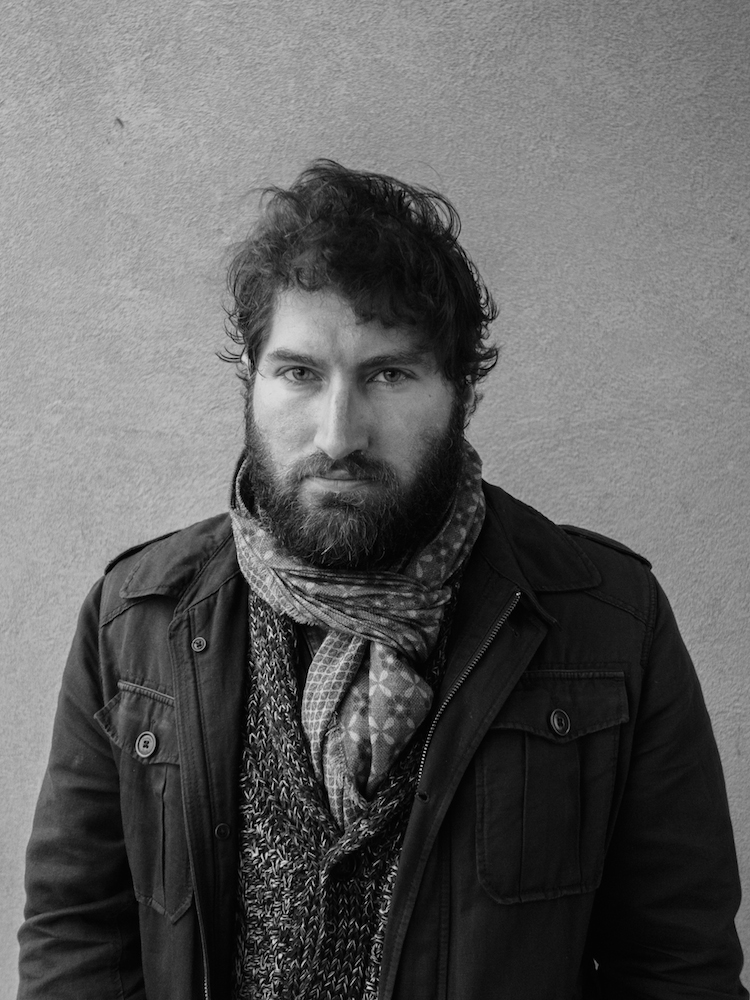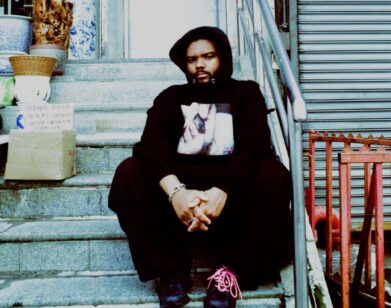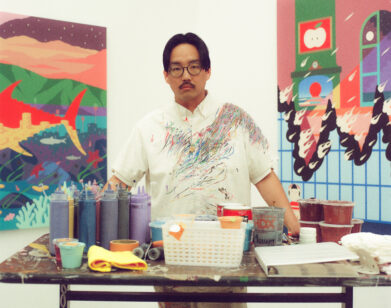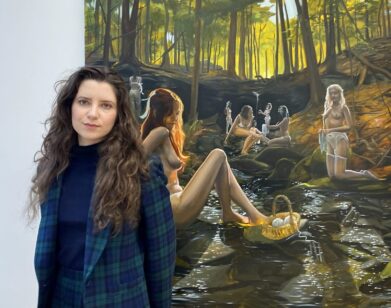America’s Front Line
PETER VAN AGTMAEL IN NEW YORK, FEBRUARY 2017. PORTRAITS: MARK DAVIS.
Peter van Agtmael’s photographs show us the surreal landscape of the United States post-9/11. In his affective, highly acclaimed 2014 book, Disco Night Sept 11 (which The New York Times Magazine, Time, and American Photo all listed as one of the best books of the year), he showed us soldiers in training, on the frontlines in Iraq and Afghanistan, and in quiet moments at home. While Van Agtmael no longer covers war in-person, he arguably still does a type of “war photography:” in his new book Buzzing at the Sill (Kehrer Verlag), out now, he looks at the long, dark shadow that battles overseas cast on the U.S. homefront.
The scenes collected in Buzzing‘s pages are community events, homes, and families, which together illustrate the stark variety of perspectives and landscapes in America. Rather than the gore often depicted in war photography, you see the Kentucky Derby, the second line parade in New Orleans, a group of KKK members, a family in Detroit, a Syrian refugee living in Illinois, and images of Van Agtmael’s own family. The connections to war are drawn through calm, everyday interactions. In one image of Nigerian photographer TY Bello, titled Lagos, Nigeria (2016), she is playing with her sons while wearing a black robe. She is smiling, looking down with her arms reached out to her sides. The caption explains that while Van Agtmael was photographing he had “a powerful flashback” to one of the Abu Ghraib torture photographs. “My memories of traumatic experiences come to me less and less, but they are always defined by their sudden invasiveness into otherwise idyllic settings,” Van Agtmael writes. These stories, in both images and words, form a picture of America at war—not abroad, but within our own borders.
Earlier this month Interview spoke to Van Agtmael, who is a member of Magnum Photos, at his apartment in Brooklyn.
TESS MAYER: How did Buzzing at the Sill come about? Is it a kind of a sequel to Disco Night Sept 11?
PETER VAN AGTMAEL: Disco Night is very much of America at war in Iraq and Afghanistan. It’s not so much about Iraq and Afghanistan although it’s largely set there. … [It’s about] the American way of waging war and what happens when that war comes home to the United States—both who we are and how we respond societally, and the lives of people after they come home and their families. There are a few autobiographical elements where I feel like my story has more universal overtones. I try not to talk about myself unnecessarily, but I think that some of the encounters I’ve had with my parents and my thoughts mirrored those of people that had spent time in these places. Part-way through when I was working on this I was easing out of going to conflict zones quite as much as I had been. Being in Iraq and Afghanistan with the military opened up a lot of questions of what it meant to be an American at this moment. I realized how little I knew about the country growing up in the D.C. suburbs. I went to Yale. In terms of economics and in terms of politics, I had fairly little exposure to the world around me. In Iraq and Afghanistan, by embedding in the military, I saw a real cross section of society. And as I started visiting [soldiers] at home it made me realize that just looking at the military coming home is a pretty limited way of looking at the U.S. What happens if I take away all thematic barriers and just see what I can in as expansive a way as possible?
MAYER: I was really interested in your caption for the image Lagos, Nigeria of this woman dancing in a cape and how you connected it to the Abu Ghraib images.
VAN AGTMAEL: It’s not an immediate torture reference. I don’t know if you pulled up the [Abu Ghraib] images after looking, but there are these eerie undertones.
MAYER: Were a lot of these images taken on assignment?
VAN AGTMAEL: Maybe about a third. Not a lot of them necessarily ran. They weren’t directly related to the parameters of the assignment. A lot of them aren’t traditional magazine pictures by any means.
MAYER: You include a handful of images of this one family from Detroit: the photo of a boy with a bow and arrow, and of the mother, and the other kids. Is that something where you went back a few times on your own? Or was that a specific assignment?
VAN AGTMAEL: I went there initially as an assignment. And I really did click with that family. I went back a few times afterwards not on an assignment. I connected with them, I thought the pictures were powerful. I just put a few in the book—there were a lot of other ones.
MAYER: There was a Facebook post by the mother that you quoted in the caption of the photo of her.
VAN AGTMAEL: Yeah—about their house burning down and a suicide [in their family]. That was terrible. They can’t catch a break.
MAYER: That, and the captions generally, struck me. You’re looking through the photos and then when you finish, you have to go to the back of the book and read the captions to get the stories. You go in-depth into what’s happened after or before the photo. It’s not a more traditional photojournalist caption that you see—”This person at this location on X date and X date.” It gives a different context. You connect sometimes seemingly random stories to photos.
VAN AGTMAEL: Sometimes the picture is more interesting than what’s going on. Sometimes the picture is suggestive of greater things in society or the history of what might be connected to the theme in the pictures—and those are worth exploring.
MAYER: Was it deliberate to have the captions at the end in Buzzing at the Sill? Unlike in Disco Night, where they’re next to the photograph.
VAN AGTMAEL: Yes. In Disco Night it serves the purpose of the text and images having a certain amount of equal weight. There are plenty of good pictures but it wasn’t too aestheticized. I was weary of that given the subject matter. I wanted the design to reflect the way I was taking pictures and the way I was thinking about things, which wasn’t just in photographs certainly. In Buzzing at the Sill the craft was more important to me in a way. I wanted a more intimate book, but I wanted the pictures to be bigger too because they’re more detailed. Some photos have to be bigger to read well. I was going on intuition more than anything. And the captions were less central than the pictures themselves, so I didn’t mind separating them. I don’t think this book would be nearly as strong if it were laid out like Disco Night.
MAYER: Just yesterday I saw that The New York Times posted a photo of yours at Standing Rock. How was photographing there?
VAN AGTMAEL: It was a pretty interesting story. The core of the story was about the youth council that created the conditions to make it a movement and continue to be the dominant leadership. Within that it was also about the scene at the camp, and it was the weekend when all these veterans were coming in. It was also when the Army Corps of Engineers [denied an easement for] the pipeline, and there were still these marches, and a huge blizzard came in. It was all pretty powerful experience. You stay in tents and the conditions are miserable but people are so passionate about why they’re there.
MAYER: Do you think you’re going back?
VAN AGTMAEL: It’s possible. It depends on if things start to shift there. If they keep resisting while the pipeline starts to be built, which it appears it will be, then I would certainly want to go back and document that process.
MAYER: I was reading an interview on Lens blog where you described being frustrated that “experiences that profoundly affected [you] weren’t being shown,” and that you blamed the media “for not allowing the depth of the perspective to get out.” Did you mean that publications choose the wrong photos?
VAN AGTMAEL: Not necessarily the wrong photos—maybe just the softer version of reality. It all depends on the context. American soldiers getting hurt and dying, you’re much less likely to see that; it’s been statistically validated how few images, in comparison to Vietnam, ran of injured and dying Americans in these wars. It was a rare thing.
I think the big question that everyone is asking themselves, or what they should be asking themselves right now, is what role has the media played in not just missing a certain part of American society that wanted to vote for, say, Donald Trump, but what role has the media played in dehumanizing other people and helping create these conditions that people are so afraid of, say, Muslims and extremism? It’s only loosely tied to the threat to our borders. It’s strange that these seemingly liberal institutions—the media and Hollywood, beyond politics—certainly break the barriers of dehumanizing imagery.
MAYER: How do you know when these projects end? For projects like yours on the KKK you have to immerse yourself in a community—is there a point where you know you have to leave?
VAN AGTMAEL: I assume nothing is over until there’s something more decisive than my own thoughts. I did some trips with Vegas [Tenold] regarding the KKK. I thought I had seen it through for that moment of time but I could well go back. I went with him recently and photographed Richard Spencer, who he was interviewing. That’s a new twist on that story. I don’t think anything is every necessarily over. And all these books, it’s not agonizing to end it because they’re not really over. They bleed into each other. … I think things take their natural form. I don’t want to just hang on to these photos for decades until there’s one decisive thing I can make at the end of it. I can still do that if I want to from the fragments of all these other books.
MAYER: To circle all the way back, I know you studied history at Yale. Did you have a moment where you realized you wanted to get into photography? Was it a gradual interest?
VAN AGTMAEL: I was interested in journalism as being a more tangible form of looking at the world than academia. Studying history seemed a bit abstract to me, so journalism seemed to employ a lot of the things that interested me about history but in a more tactile way. That was the logical part of it. But then I took a photography class, something I hadn’t had much direct interest in before. It was such a revelation—a physical experience almost. I felt a lot of clarity very quickly that probably my path in life was as a photographer. Then the September 11th attacks happened about eight or nine months after I started taking pictures. Suddenly I had something to drive the vagueness of my interest. I had the interest in history, but what was it about history? Conflict interested me certainly. … When Sept 11th happened it was kind of an intersection of my interests in photography, my interest in history, and my interest in conflict. And so very quickly after I had this sense of direction that I wanted to look at what had come from September 11th—mainly at the early stages of these wars in Iraq and Afghanistan, and since then it’s expanded into not just what came from that moment, but how that moment came about in the first place: what the conditions of the country [are that] make us react as we do. These are enormous questions obviously, which is why it will take me who knows how many books to explore that question. There will never be any real resolution, just certain aspects of clarity that don’t necessarily explain everything. I wish it did.
BUZZING AT THE SILL (KEHRER VERLAG) IS OUT NOW. FOR MORE ON PETER VAN AGTMAEL, VISIT HIS WEBSITE.







